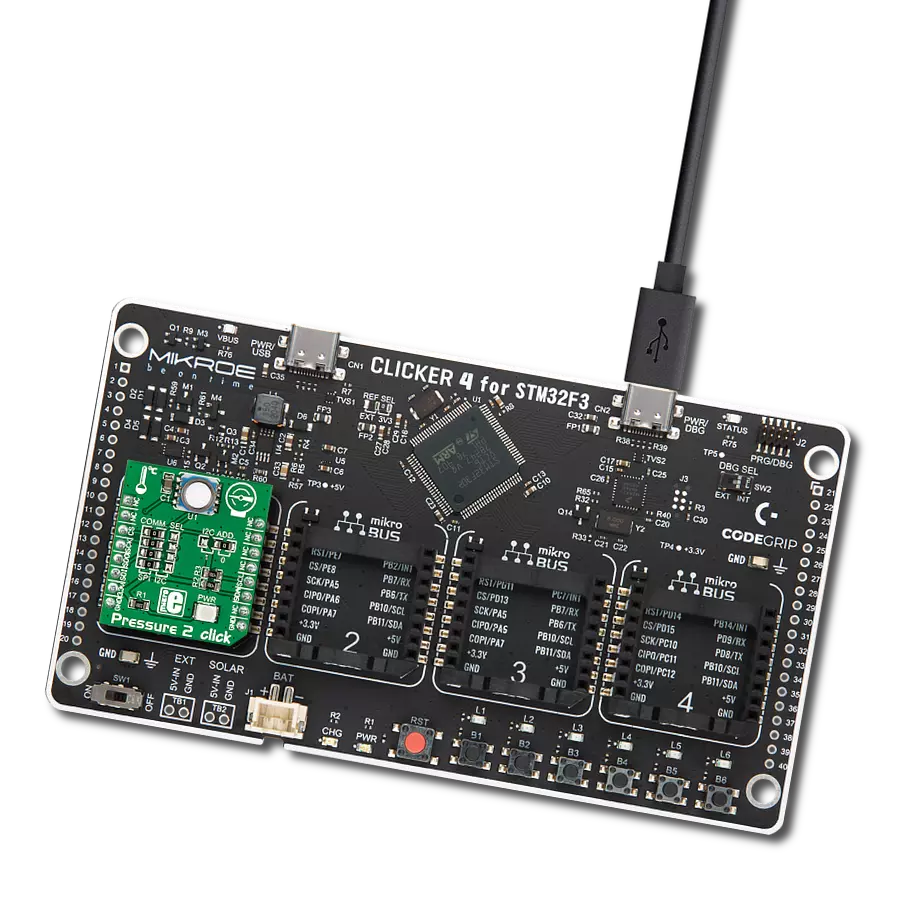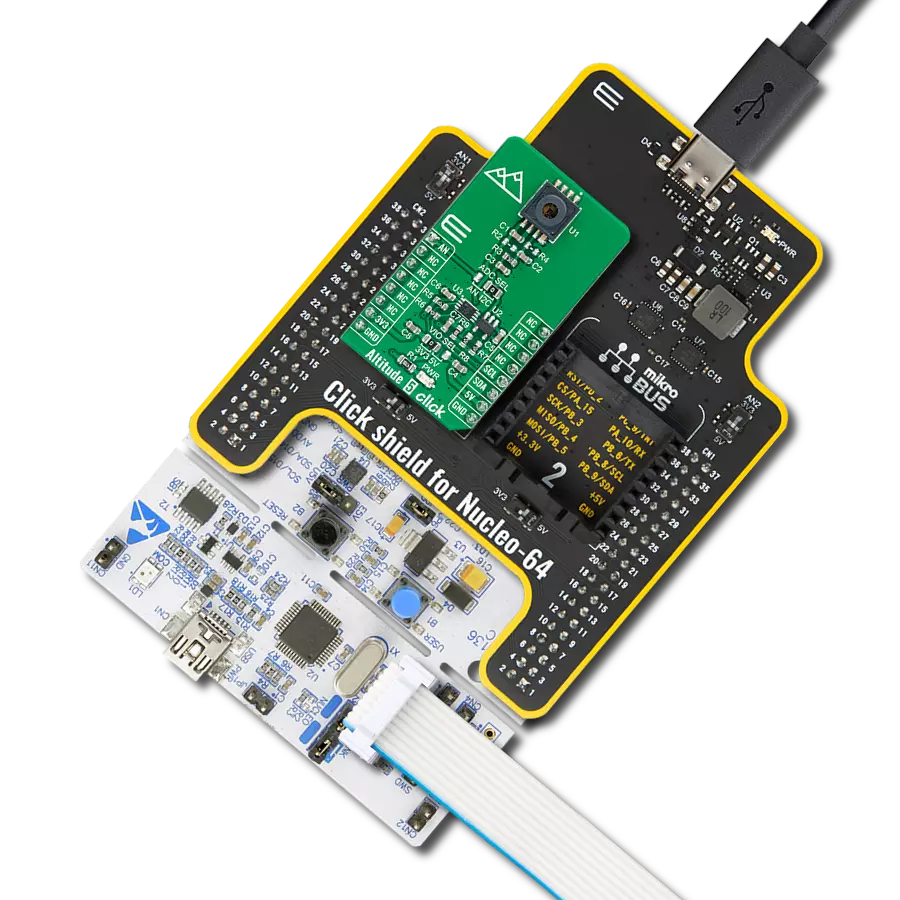Our digital pressure sensors are at the forefront of measurement technology, offering unparalleled accuracy for critical applications, from industrial processes to scientific research
A
A
Hardware Overview
How does it work?
Pressure 10 Click is based on the HSPPAD042A, a digital pressure sensor from ALPS Alpine. This sensor consists of a piezoresistive pressure sensing element and a mixed-signal ASIC which performs A/D conversions and provides the conversion results through a digital interface. MEMS technology, which this sensor element is made of, offers a high sensing precision with ±0.7hPa absolute and ±0.05hPa relative pressure accuracy and industry-lowest current consumption of 1.8μA in low power mode. The sensor is enclosed in a small LGA package and can operate in a range of 300 hPa to 1100 hPa but can withstand up to 30,000 hPa before the membrane breaks down. The HSPPAD042A offers a set of pressure and temperature measurement options. Several measurement modes can be set by CTL1.MODE
bit in 0x0F register. After software reset command is detected, the digital regulator is disabled and all register values are reset and measurement mode is set to Register Action Mode. FIFO buffer allows for an optimization of the host firmware, reducing the data traffic through the communication interface. The interrupt is available over the RDY pin (Data Ready pin), and can be used to indicates measurement completion. Multiple flags can be set to the RDY pin. They are all OR output and the change will be effective immediately even during the measurement. Pressure 10 Click offers a choice between two interfaces: I2C and SPI. The selection can be done by positioning SMD jumpers labeled as COMM SEL to an appropriate position. Note that all the jumpers must be placed to the same side, or else the Click board™ may become
unresponsive. While the I2C interface is selected, the HSPPAD042A allows the choice of the least significant bit (LSB) of its I2C slave address. This can be done by using the SMD jumper labeled as ADDR SEL. This Click Board™ uses both I2C and SPI communication interfaces. It is designed to be operated only with 3.3V logic levels. A proper logic voltage level conversion should be performed before the Click board™ is used with MCUs with logic levels of 5V. More information about the HSPPAD042A can be found in the attached datasheet. However, the Click board™ comes equipped with a library that contains easy to use functions and a usage example that may be used as a reference for the development.
Features overview
Development board
PIC18F57Q43 Curiosity Nano evaluation kit is a cutting-edge hardware platform designed to evaluate microcontrollers within the PIC18-Q43 family. Central to its design is the inclusion of the powerful PIC18F57Q43 microcontroller (MCU), offering advanced functionalities and robust performance. Key features of this evaluation kit include a yellow user LED and a responsive
mechanical user switch, providing seamless interaction and testing. The provision for a 32.768kHz crystal footprint ensures precision timing capabilities. With an onboard debugger boasting a green power and status LED, programming and debugging become intuitive and efficient. Further enhancing its utility is the Virtual serial port (CDC) and a debug GPIO channel (DGI
GPIO), offering extensive connectivity options. Powered via USB, this kit boasts an adjustable target voltage feature facilitated by the MIC5353 LDO regulator, ensuring stable operation with an output voltage ranging from 1.8V to 5.1V, with a maximum output current of 500mA, subject to ambient temperature and voltage constraints.
Microcontroller Overview
MCU Card / MCU

Architecture
PIC
MCU Memory (KB)
128
Silicon Vendor
Microchip
Pin count
48
RAM (Bytes)
8196
You complete me!
Accessories
Curiosity Nano Base for Click boards is a versatile hardware extension platform created to streamline the integration between Curiosity Nano kits and extension boards, tailored explicitly for the mikroBUS™-standardized Click boards and Xplained Pro extension boards. This innovative base board (shield) offers seamless connectivity and expansion possibilities, simplifying experimentation and development. Key features include USB power compatibility from the Curiosity Nano kit, alongside an alternative external power input option for enhanced flexibility. The onboard Li-Ion/LiPo charger and management circuit ensure smooth operation for battery-powered applications, simplifying usage and management. Moreover, the base incorporates a fixed 3.3V PSU dedicated to target and mikroBUS™ power rails, alongside a fixed 5.0V boost converter catering to 5V power rails of mikroBUS™ sockets, providing stable power delivery for various connected devices.
Used MCU Pins
mikroBUS™ mapper
Take a closer look
Click board™ Schematic

Step by step
Project assembly
Track your results in real time
Application Output
1. Application Output - In Debug mode, the 'Application Output' window enables real-time data monitoring, offering direct insight into execution results. Ensure proper data display by configuring the environment correctly using the provided tutorial.

2. UART Terminal - Use the UART Terminal to monitor data transmission via a USB to UART converter, allowing direct communication between the Click board™ and your development system. Configure the baud rate and other serial settings according to your project's requirements to ensure proper functionality. For step-by-step setup instructions, refer to the provided tutorial.

3. Plot Output - The Plot feature offers a powerful way to visualize real-time sensor data, enabling trend analysis, debugging, and comparison of multiple data points. To set it up correctly, follow the provided tutorial, which includes a step-by-step example of using the Plot feature to display Click board™ readings. To use the Plot feature in your code, use the function: plot(*insert_graph_name*, variable_name);. This is a general format, and it is up to the user to replace 'insert_graph_name' with the actual graph name and 'variable_name' with the parameter to be displayed.

Software Support
Library Description
This library contains API for Pressure 10 Click driver.
Key functions:
pressure10_send_cmd- Send commandpressure10_check_communication- Check communicationpressure10_get_status- Get status function
Open Source
Code example
The complete application code and a ready-to-use project are available through the NECTO Studio Package Manager for direct installation in the NECTO Studio. The application code can also be found on the MIKROE GitHub account.
/*!
* \file
* \brief Pressure10 Click example
*
* # Description
* Pressure 10 Click features a digital interface barometric pressure sensor, based on
* piezoresistive bridge. It can use both SPI and I2C communication protocols, allowing
* it to be interfaced with a broad range of MCUs.
*
* The demo application is composed of two sections :
*
* ## Application Init
* Initializes the driver, checks the communication and configures the module for measurement.
*
* ## Application Task
* Reads the pressure and temperature data every 1500ms and displays the results on the USB UART.
*
* \author MikroE Team
*
*/
// ------------------------------------------------------------------- INCLUDES
#include "board.h"
#include "log.h"
#include "pressure10.h"
// ------------------------------------------------------------------ VARIABLES
static pressure10_t pressure10;
static log_t logger;
static uint8_t check_com;
// ------------------------------------------------------ APPLICATION FUNCTIONS
void application_init ( void )
{
log_cfg_t log_cfg;
pressure10_cfg_t cfg;
/**
* Logger initialization.
* Default baud rate: 115200
* Default log level: LOG_LEVEL_DEBUG
* @note If USB_UART_RX and USB_UART_TX
* are defined as HAL_PIN_NC, you will
* need to define them manually for log to work.
* See @b LOG_MAP_USB_UART macro definition for detailed explanation.
*/
LOG_MAP_USB_UART( log_cfg );
log_init( &logger, &log_cfg );
log_info( &logger, "---- Application Init ----" );
// Click initialization.
pressure10_cfg_setup( &cfg );
PRESSURE10_MAP_MIKROBUS( cfg, MIKROBUS_1 );
pressure10_init( &pressure10, &cfg );
check_com = pressure10_check_communication( &pressure10 );
if ( check_com == 0 )
{
log_printf( &logger, ">> Communication [OK]\r\n" );
}
else
{
log_printf( &logger, ">> Communication [ERROR]\r\n" );
for( ; ; );
}
pressure10_default_cfg ( &pressure10 );
log_printf( &logger, "----------------------------\r\n" );
}
void application_task ( void )
{
float temperature;
float pressure;
pressure = pressure10_get_pressure( &pressure10 );
temperature = pressure10_get_temperature( &pressure10 );
log_printf( &logger, ">> Temperature: %.2f C\r\n", temperature );
log_printf( &logger, "----------------------------\r\n" );
log_printf( &logger, ">> Pressure: %.2f mBar\r\n", pressure );
log_printf( &logger, "----------------------------\r\n" );
Delay_ms ( 1000 );
Delay_ms ( 500 );
}
int main ( void )
{
/* Do not remove this line or clock might not be set correctly. */
#ifdef PREINIT_SUPPORTED
preinit();
#endif
application_init( );
for ( ; ; )
{
application_task( );
}
return 0;
}
// ------------------------------------------------------------------------ END
Additional Support
Resources
Category:Pressure




































